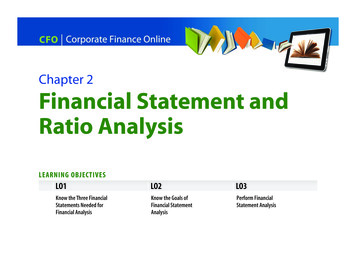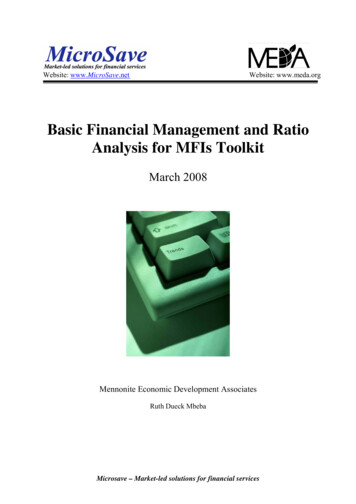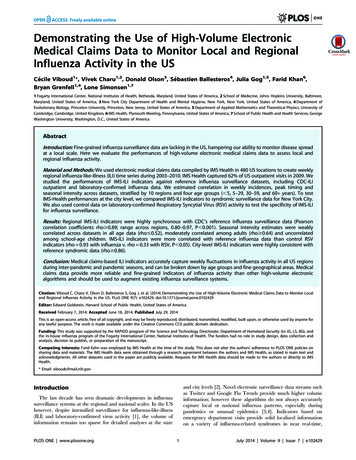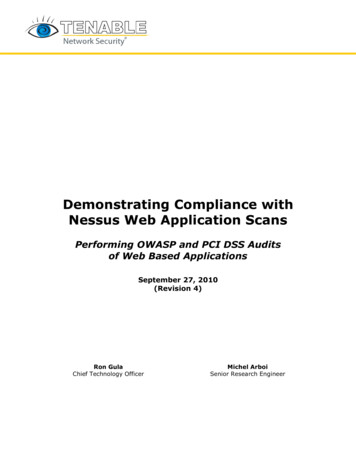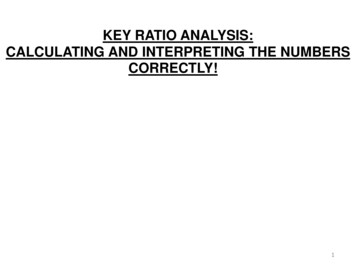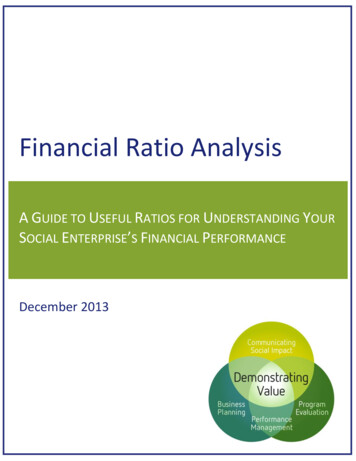
Transcription
Financial Ratio AnalysisA GUIDE TO USEFUL RATIOS FOR UNDERSTANDING YOURSOCIAL ENTERPRISE’S FINANCIAL PERFORMANCEDecember 2013
Ratio AnalysisAcknowledgmentsThis guide and supporting tools were developed by Julie Poznanski, Bryn Sadownikand Irene Gannitsos as part of the Demonstrating Value Initiative at VancityCommunity Foundation. The guide was released in December 2010, with minorupdates in December 2013. Further copies of the guide can be downloaded atwww.demonstratingvalue.org.i Page
Ratio AnalysisContentsIntroduction . 1The Ratios . 2Profitability Sustainability Ratios. 2Operational Efficiency Ratios . 5Liquidity Ratios . 7Leverage Ratios . 9Other Ratios . 10ii P a g e
Ratio AnalysisIntroductionA sustainable business and mission requires effective planning and financialmanagement. Ratio analysis is a useful management tool that will improve yourunderstanding of financial results and trends over time, and provide key indicators oforganizational performance. Managers will use ratio analysis to pinpoint strengthsand weaknesses from which strategies and initiatives can be formed. Funders may useratio analysis to measure your results against other organizations or make judgmentsconcerning management effectiveness and mission impactFor ratios to be useful and meaningful, they must be:o Calculated using reliable, accurate financial information (does your financialinformation reflect your true cost picture?)o Calculated consistently from period to periodo Used in comparison to internal benchmarks and goalso Used in comparison to other companies in your industryo Viewed both at a single point in time and as an indication of broad trends andissues over timeo Carefully interpreted in the proper context, considering there are many otherimportant factors and indicators involved in assessing performance.Ratios can be divided into four major categories:ooooProfitability SustainabilityOperational EfficiencyLiquidityLeverage (Funding – Debt, Equity, Grants)The ratios presented below represent some of the standard ratios used in businesspractice and are provided as guidelines. Not all these ratios will provide theinformation you need to support your particular decisions and strategies. You can alsodevelop your own ratios and indicators based on what you consider important andmeaningful to your organization and stakeholders.1 Page
Ratio AnalysisThe RatiosProfitability Sustainability RatiosHow well is our business performing over a specific period, will your social enterprisehave the financial resources to continue serving its constituents tomorrow as well astoday?RatioWhat does it tell you?Sales Growth Percentage increase (decrease) in salesbetween two time periods.Current Period – Previous Period SalesPrevious Period SalesReliance on Revenue Source Revenue SourceTotal RevenueIf overall costs and inflation are increasing, thenyou should see a corresponding increase insales. If not, then may need to adjust pricingpolicy to keep up with costs.Measures the composition of an organization’srevenue sources (examples are sales,contributions, grants).The nature and risk of each revenue sourceshould be analyzed. Is it recurring, is yourmarket share growing, is there a long termrelationship or contract, is there a risk thatcertain grants or contracts will not be renewed,is there adequate diversity of revenue sources?Organizations can use this indicator todetermine long and short-term trends in line withstrategic funding goals (for example, movetowards self-sufficiency and decreasing relianceon external funding).2 Page
Ratio AnalysisProfitability Sustainability Ratios continuedOperating Self-Sufficiency Business RevenueTotal ExpensesMeasures the degree to which theorganization’s expenses are covered by itscore business and is able to functionindependent of grant support.For the purpose of this calculation, businessrevenue should exclude any non-operatingrevenues or contributions. Total expensesshould include all expenses (operating andnon-operating) including social costs.A ratio of 1 means you do not depend ongrant revenue or other funding.Gross Profit Margin Gross ProfitTotal SalesNet Profit Margin Net ProfitSalesHow much profit is earned on your productswithout considering indirect costs.Is your gross profit margin improving? Smallchanges in gross margin can significantly affectprofitability. Is there enough gross profit tocover your indirect costs. Is there a positivegross margin on all products?How much money are you making per every of sales. This ratio measures your ability tocover all operating costs including indirect costsSGA to Sales Percentage of indirect costs to sales.Indirect Costs (sales, general, admin)SalesLook for a steady or decreasing ratio whichmeans you are controlling overhead3 Page
Ratio AnalysisProfitability Sustainability Ratios continuedReturn on Assets Net ProfitAverage Total AssetsMeasures your ability to turn assets into profit.This is a very useful measure of comparisonwithin an industry.A low ratio compared to industry may meanthat your competitors have found a way tooperate more efficiently. After tax interestexpense can be added back to numeratorsince ROA measures profitability on all assetswhether or not they are financed by equity ordebtReturn on Equity Rate of return on investment by shareholders.Net ProfitAverage Shareholder EquityThis is one of the most important ratios toinvestors. Are you making enough profit tocompensate for the risk of being in business?How does this return compare to less riskyinvestments like bonds?4 Page
Ratio AnalysisOperational Efficiency RatiosHow efficiently are you utilizing your assets and managing your liabilities? Theseratios are used to compare performance over multiple periods.RatioWhat does it tell youOperating Expense Ratio Compares expenses to revenue.Operating ExpensesTotal RevenueA decreasing ratio is considered desirablesince it generally indicates increased efficiency.Accounts Receivable Turnover Number of times trade receivables turnoverduring the year.Net SalesAverage Accounts ReceivableDays in Accounts Receivable Average Accounts ReceivableSales x 365Inventory Turnover Cost of SalesAverage InventoryDays in Inventory Average InventoryCost of Sales x 365The higher the turnover, the shorter the timebetween sales and collecting cash.What are your customer payment habitscompared to your payment terms. You mayneed to step up your collection practices ortighten your credit policies.These ratios are only useful if majority of salesare credit (not cash) sales.The number of times you turn inventory overinto sales during the year or how many days ittakes to sell inventory.This is a good indication of production andpurchasing efficiency. A high ratio indicatesinventory is selling quickly and that little unusedinventory is being stored (or could also meaninventory shortage). If the ratio is low, itsuggests overstocking, obsolete inventory orselling issues.5 Page
Ratio AnalysisOperational Efficiency Ratios ContinuedAccounts Payable Turnover Cost of SalesAverage Accounts PayableDays in Accounts Payable Average Accounts PayableCost of Sales x 365Total Asset Turnover RevenueAverage Total AssetsThe number of times trade payables turn overduring the year.The higher the turnover, the shorter the periodbetween purchases and payment. A highturnover may indicate unfavourable supplierrepayment terms. A low turnover may be asign of cash flow problems.Compare your days in accounts payable tosupplier terms of repayment.How efficiently your business generates saleson each dollar of assets.An increasing ratio indicates you are using yourassets more productively.Fixed Asset Turnover RevenueAverage Fixed Assets6 Page
Ratio AnalysisLiquidity RatiosDoes your enterprise have enough cash on an ongoing basis to meet its operationalobligations? This is an important indication of financial health.RatioWhat does it tell you?Current Ratio Measures your ability to meet short termobligations with short term assets., a usefulindicator of cash flow in the near future.Current AssetsCurrent Liabilities(also known as Working Capital Ratio)A social enterprise needs to ensure that it canpay its salaries, bills and expenses on time.Failure to pay loans on time may limit yourfuture access to credit and therefore yourability to leverage operations and growth.A ratio less that 1 may indicate liquidity issues.A very high current ratio may mean there isexcess cash that should possibly be investedelsewhere in the business or that there is toomuch inventory. Most believe that a ratiobetween 1.2 and 2.0 is sufficient.The one problem with the current ratio is that itdoes not take into account the timing of cashflows. For example, you may have to paymost of your short term obligations in the nextweek though inventory on hand will not be soldfor another three weeks or account receivablecollections are slow.7 Page
Ratio AnalysisLiquidity Ratios ContinuedQuick Ratio Cash AR Marketable SecuritiesCurrent LiabilitiesA more stringent liquidity test that indicates if afirm has enough short-term assets (withoutselling inventory) to cover its immediateliabilities.This is often referred to as the “acid test”because it only looks at the company’s mostliquid assets only (excludes inventory) that canbe quickly converted to cash).A ratio of 1:1 means that a social enterprisecan pay its bills without having to sell inventory.Working Capital Current Assets – Current LiabilitiesAdequacy of Resources Cash Marketable Securities AccountsReceivableMonthly ExpensesWC is a measure of cash flow and shouldalways be a positive number. It measures theamount of capital invested in resources that aresubject to quick turnover. Lenders often use thisnumber to evaluate your ability to weatherhard times. Many lenders will require that acertain level of WC be maintained.Determines the number of months you couldoperate without further funds received (burnrate)8 Page
Ratio AnalysisLeverage RatiosTo what degree does an enterprise utilize borrowed money and what is its level ofrisk? Lenders often use this information to determine a business’s ability to repay debt.RatioWhat does it tell you?Debt to Equity Compares capital invested byowners/funders (including grants) andfunds provided by lenders.Short Term Debt Long Term DebtTotal Equity (including grants)Lenders have priority over equityinvestors on an enterprise’s assets.Lenders want to see that there is somecushion to draw upon in case of financialdifificulty. The more equity there is, themore likely a lender will be repaid. Mostlenders impose limits on the debt/equityratio, commonly 2:1 for small businessloans.Too much debt can put your business atrisk, but too little debt may limit yourpotential. Owners want to get someleverage on their investment to boostprofits. This has to be balanced with theability to service debt.Interest Coverage EBITDAInterest ExpenseMeasures your ability to meet interestpayment obligations with business income.Ratios close to 1 indicates companyhaving difficulty generating enough cashflow to pay interest on its debt. Ideally,a ratio should be over 1.59 Page
Ratio AnalysisOther RatiosYou may want to develop your own customized ratios to communicate results that arespecific and important to your organization. Here are some examples.Operating Self-Sufficiency Sales RevenueTotal Costs (Operating and Social Costs)% Staffing Costs spent on Target Group Target Staff CostsTotal Staffing CostsSocial Costs per Employee Total Social CostsNumber of Target Employees% Social Costs covered by Grants Grant IncomeTotal Social Costs10 P a g e
Ratio analysis is a useful management tool that will improve your understanding of financial results and trends over time, and provide key indicators of organizational performance. Managers will use ratio analysis to pinpoint strengths and weaknesses
